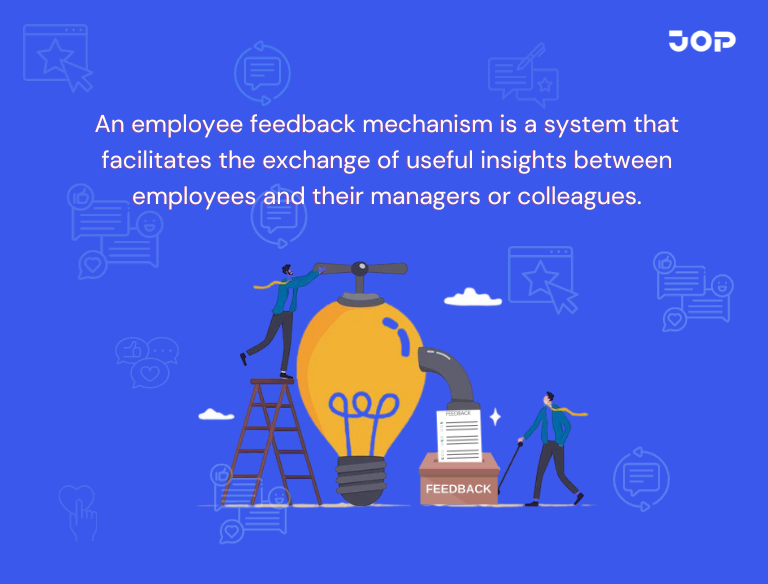An effective employee feedback mechanism isn’t just about giving compliments—it’s about fostering meaningful growth and improvement.
In today’s fast-paced professional world, constructive feedback drives both personal and organizational development, keeping employees motivated and refining their skills.
This blog explores how a robust employee feedback mechanism can transform workplace communication, helping teams thrive through actionable insights.

What is an Employee Feedback Mechanism?
An employee feedback mechanism is a structured system that facilitates the exchange of valuable insights between employees and their managers or higher-level executives.
It serves as a crucial conduit for employees to provide input, enabling them to express their opinions and concerns in a constructive manner.
Simultaneously, this mechanism empowers managers to offer feedback to their team members, a process that is essential for improving performance and fostering growth within the organization.
This feedback can encompass both positive feedback and constructive criticism, addressing various aspects of an employee’s role or the overall organizational landscape.
By utilizing this mechanism, managers and higher-level executives gain a comprehensive understanding of their employees’ needs and concerns, enabling them to make well-informed decisions that promote a harmonious and productive work environment.
About the Traditional Feedback Methods
Traditional feedback methods are like the old faithful we’ve been using for years. They include one-on-one meetings, those sit-down chats that let you and your team member dive deep into their performance.
Then there are the annual performance reviews, where you get the big picture of how they’ve been doing throughout the year, set some goals, and talk about their career path. And of course, there are written evaluations, which help us keep track of everything discussed.
Now, let’s talk about the pros and cons of these methods. One-on-one meetings are fantastic for building strong relationships and having real, honest conversations. However, they might not capture the big picture over the long term.
Annual reviews give you that bird’s-eye view, but they can be a bit time-consuming, and sometimes, recent events overshadow the year’s performance. And written evaluations, while good for documentation, might not capture the nuances of a face-to-face chat. Also, these traditional methods can be a bit inflexible, which doesn’t always work well in our fast-paced marketing world.
That’s why many modern companies are adding more agile, continuous feedback processes to the mix, to make sure we’re getting the best of both worlds when it comes to managing performance and helping our team members grow.
12 Different Types of Feedback Mechanisms or Systems
1: Surveys
Surveys are like our friendly feedback questionnaires. You create a set of questions, usually about specific topics like teamwork, communication, or job satisfaction, and send them out to your team. The best part? It’s all anonymous, so everyone can be candid without any fear of repercussions. Once you collect the responses, you get to see the big picture and identify areas that need some attention.
Example: Imagine you want to boost team communication. You send out a survey asking, “How happy are you with our team’s communication on a scale of 1 to 5?” and “Got any ideas to make it better?” After collecting the responses, you notice that most team members feel we can improve by having regular status meetings.
2: Performance Reviews
Think of performance reviews as your annual check-up with the doctor, but for your career. You and your team member sit down and have a structured chat about their performance. You discuss their accomplishments, what they’re awesome at, and where they can grow. All of this is typically based on goals and performance metrics you’ve set together.
Example: During an annual performance review, you get to celebrate your team member’s wins, like hitting those sales targets out of the park. Then, you chat about where there’s room for improvement. Maybe it’s time management. Together, you set new goals and work on a plan to tackle those weak spots. It’s a great way to keep everyone on the same page and moving forward.
3: 1-1 Meetings
One-on-one meetings are your chance to have a cozy, private chat with your team members. It’s where the real magic happens. You can talk about current projects, sort out any issues, give props for a job well done, and offer guidance—all in a relaxed and personal setting.
Example: Let’s say you have a bi-weekly one-on-one with a team member. You start off by asking about their workload and what they’ve been up to. You notice they knocked it out of the park in a recent client presentation, so you give them a high-five for their communication skills. Then, you tackle a recent hiccup where a project missed its deadline, and you brainstorm ways to improve time management. These chats build a strong bond and ensure everyone’s on track.
4: 360-Degree Assessment
Picture this: It’s like getting feedback from all angles! The 360-degree assessment, also known as multi-rater feedback, is your secret weapon. It doesn’t just rely on your opinion as a manager. Instead, it collects input from various sources – your team member’s supervisor, their colleagues, and maybe even their own self-reflection. It’s like creating a feedback quilt that tells the whole story.
Example: Let’s say you want to help Sarah, one of your team members, level up. You gather insights from her boss, co-workers, anyone who reports to her, and Sarah herself. They’d all chime in on specific things like her communication skills, leadership style, or teamwork. Then, you put it all together and share this comprehensive feedback with Sarah. It’s like giving her a mirror to see herself from every angle, and it can be a game-changer for her growth.
5: Group Discussions
Imagine a team pow-wow but with structure! Group discussions are where your team members come together to chat about work stuff. It can be led by you as the manager or someone else on the team. The goal? To hash out what’s going well, what could use a boost, and any hurdles in the way.
Example: Let’s say you just wrapped up a project with your team. You could set up a group discussion where everyone takes turns sharing their thoughts. What rocked about the project? What could’ve been smoother? Any roadblocks they faced? It’s an open, honest convo where everyone’s voice matters. This helps your team learn from each other and get on the same page for future projects.
6: Exit Interviews
They are like a parting chat when someone decides to leave your team or company. It’s where you ask them about their journey, why they’re leaving, and what they thought about their time here.
Example: Let’s say John, one of your team members, is moving on to new adventures. Before he goes, you sit down for an exit interview. You want to know what led to his decision to leave and his overall experience.
John might dish out some insights about our workplace culture, leadership, or career opportunities. This info isn’t just for goodbyes – it’s like a treasure map for finding ways to make your team or company even better for the folks who stick around.
7: Anonymous Feedback Boxes or Platforms
Alright, picture this: you set up a suggestion box in the office or create an online platform where your team can spill the beans without revealing their identity. It’s like a secret agent mission but for ideas and feedback. People drop in their thoughts, suggestions, or even concerns, all while staying incognito.
Example: So, you introduce this sneaky feedback box in the breakroom. One day, someone tosses in a note suggesting a more efficient way to run those never-ending weekly meetings. They didn’t want their name attached to it, but it turns out it’s a brilliant idea! You review it, implement the changes, and voilà – your meetings are now super productive.
8: Customer Feedback
Customer feedback is like eavesdropping on what your customers are saying about your product or service. You gather this intel through surveys, online reviews, or just chatting with your clients. It’s like having a secret window into their thoughts.
Example: Let’s say you’re running a customer support team. After resolving a customer’s issue, you ask them for their thoughts. They rave about how quickly your team jumped into action and how friendly they were. You take this golden nugget of feedback and share it with your team members. They feel appreciated, and it motivates them to keep up the excellent customer service.
9: Mentorship and Coaching
Think of mentorship and coaching as those heart-to-heart talks with your team members. You sit down for a chat, set goals, and provide guidance and constructive feedback. It’s like being a coach for your team, helping them level up.
Example: Imagine you notice one of your team members is drowning in deadlines. You schedule a coaching session to discuss their challenges and work out a plan. You’re like their personal time-management guru! You offer support, check in regularly, and cheer them on as they get back on track.
10: Self-Assessment Feedback
Picture this: Your team members become the judges of their own performance! Self-assessment feedback is like a mirror where employees get to reflect on their own work. You can hand out questionnaires or have them do a little self-reflection. It’s all about encouraging self-awareness and responsibility for their own growth.
Example: Let’s say you’re leading a squad of awesome software developers. Ask them to rate themselves on coding skills, project deadlines, and teamwork over the past quarter. They can jot down what they think they’ve aced and where they need a boost. This becomes a fantastic starting point for a heart-to-heart chat during your one-on-one meetings.
11: Suggestion Programs
Imagine a suggestion box but with a high-tech twist! Suggestion programs are like open invitations for your team to share their brilliant ideas, feedback, or suggestions. They can chime in on anything from work processes to product improvements. It’s all about promoting open communication and sparking innovation.
Example: Let’s say you’re steering the ship of a customer service team. Launch a suggestion program where your team members can throw in their thoughts on how to make customer interactions smoother. One of them might suggest adopting a new customer relationship management tool for efficiency. You can review the idea with the team, discuss its feasibility, and maybe even put it into action!
12: Automated Feedback Requests
Time to bring technology into the feedback game! Automated feedback requests are like those handy survey tools that shoot out questions to gather feedback. You can customize these surveys to dig into performance, teamwork, or leadership skills. It’s like a feedback data party, but online!
Example: Imagine you’re in charge of a dynamic marketing team. Set up a cool automated feedback system that swoops in every quarter. It sends out feedback requests to team members, peers, and bosses, asking them to rate each other’s performance and teamwork skills. The responses come back anonymously, and you get a nifty report to guide your coaching and development efforts
Tailoring Feedback Mechanisms to Your Organization
Firstly, picture feedback like a tailored suit – one size doesn’t fit all. Integrating ethical feedback practices ensures that feedback feels genuine and aligns with your company’s values and goals. This approach creates trust and fosters accountability.
Imagine your company values transparency; in that case, your methods should promote creating a feedback culture that thrives on open and honest communication. When feedback flows naturally within the organization, it becomes part of the workplace DNA.
Secondly, feedback should act as a GPS guiding your organization toward its goals. For instance, incorporating positive feedback examples can inspire creativity and encourage idea-sharing among teams. On the other hand, leveraging negative feedback examples can help identify areas for improvement while still driving progress. Remember, what works for one team may not work for another—customization is key.
Now, let’s talk about choosing the right tools. Start by assessing your strengths and areas needing improvement. Tailor your feedback tools, like one-on-one meetings or surveys, to fit your team’s preferences and communication styles. A blend of peer reviews, manager feedback, and self-assessments often delivers the most comprehensive insights.
Finally, don’t forget the secret sauce: keep evolving your feedback mechanisms. Like upgrading software, staying adaptable ensures your feedback culture remains effective and impactful as your organization grows.

Gaurav Sabharwal
CEO of JOP
Gaurav is the CEO of JOP (Joy of Performing), an OKR and high-performance enabling platform. With almost two decades of experience in building businesses, he knows what it takes to enable high performance within a team and engage them in the business. He supports organizations globally by becoming their growth partner and helping them build high-performing teams by tackling issues like lack of focus, unclear goals, unaligned teams, lack of funding, no continuous improvement framework, etc. He is a Certified OKR Coach and loves to share helpful resources and address common organizational challenges to help drive team performance. Read More
 Gaurav Sabharwal
Gaurav Sabharwal
